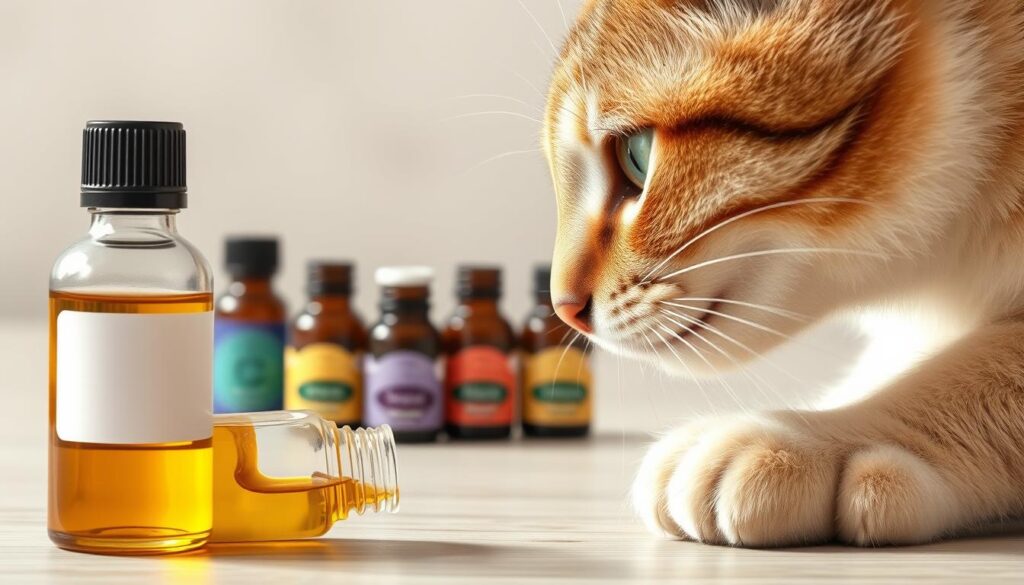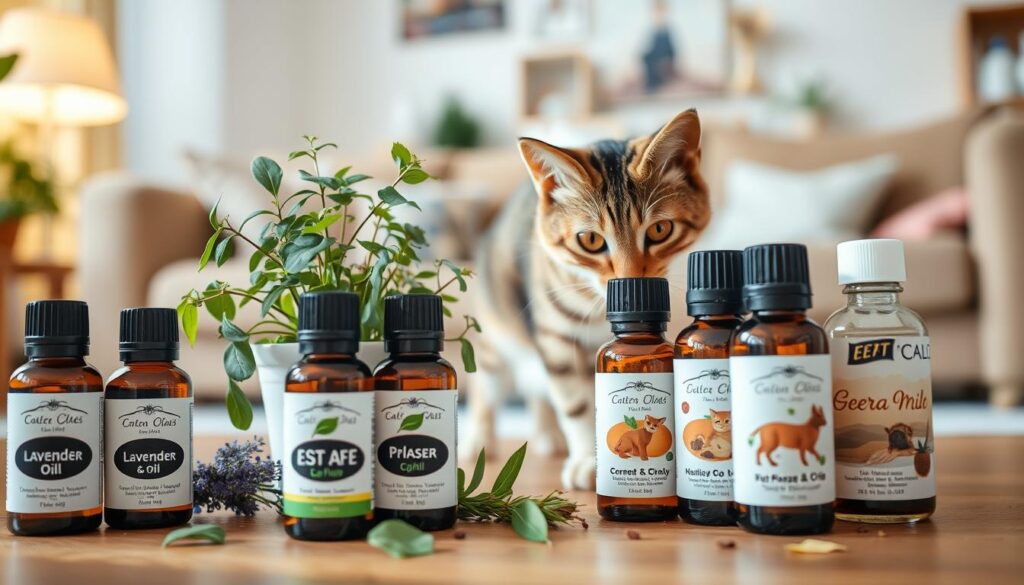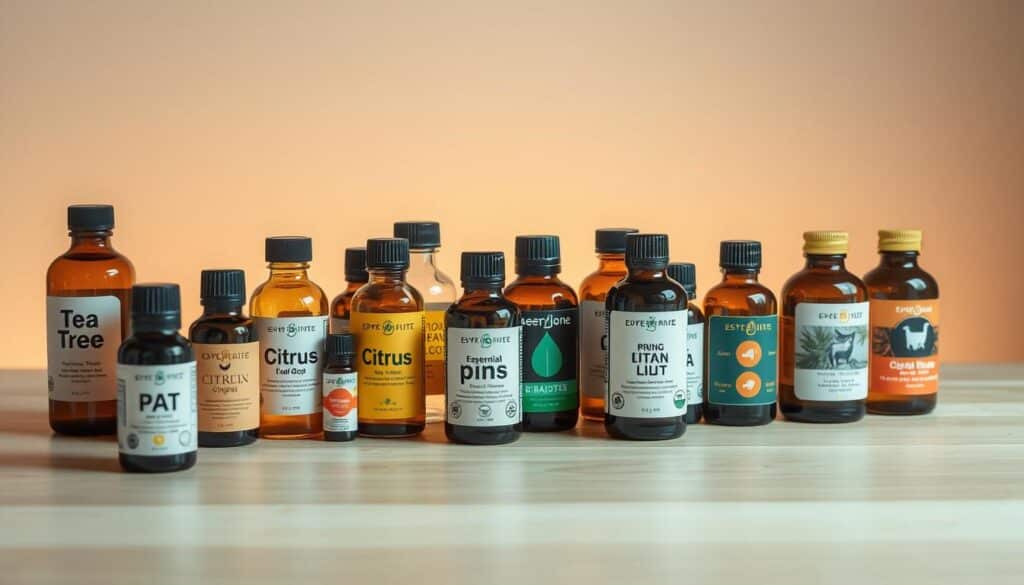What Essential Oils Are Safe For Cats? The Best 6 Alternatives To Try Now
You want a cozy home without harming your cat. This guide tells you which essential oils are safe for cats. It also shows how to use them safely and which ones to avoid.
Cats can’t handle some essential oils well. So, it’s best to diffuse them in a well-ventilated area for short times. Never put oils on your cat’s fur, food, or litter. Make sure your cat has a safe place to go.
There are safe essential oils for cats. Lavender, chamomile, frankincense, and cedarwood are good choices. They can make your home smell nice without harming your cat. But, there are oils to avoid and signs to watch for.
Before you start, set up a cool-air diffuser and keep doors open. Watch your cat closely. If they seem uncomfortable, stop, open windows, and call your vet.
Key Takeaways
- Use cat-friendly diffusers in well-ventilated rooms and keep sessions brief.
- Stick to safe oils for cats when diffused carefully: lavender, chamomile, frankincense, and cedarwood.
- Never apply essential oils to skin, food, toys, bedding, or litter.
- Avoid high-risk oils like tea tree, eucalyptus, peppermint, wintergreen, clove, cinnamon, and citrus oils.
- Watch for toxicity signs such as drooling, watery eyes, wobbliness, or trouble breathing.
- Choose pure products from reputable brands and store bottles out of reach.
- Always allow a scent-free escape route so your cat can leave the room.
Understanding Why Cats Are Sensitive to Essential Oils
You might enjoy a fresh-smelling home, but your cat feels scents differently. Cats have a much stronger sense of smell than humans. Even a mild aroma can be overwhelming for them.
When you mix strong oils with a cat’s small size and unique biology, the risk of harm increases. Making smart choices about using diffusers and cats helps keep your home comfortable and calm.

Cats’ limited liver enzymes and phenol metabolism
Your cat’s liver struggles with certain chemicals, like those tied to cat liver enzymes phenols. This means phenol toxicity in cats can build up quickly. Even small amounts of oils can stay in their system longer, raising the risk of essential oil toxicity.
Short sessions, fresh air, and giving your cat space can help. If your cat hides, drools, or seems off-balance, stop using the oils and let the air out.
Why “natural” doesn’t always mean safe for pets
Just because something is plant-based doesn’t mean it’s safe for pets. Concentrated oils can be too much for a small animal. Always check labels and doses carefully.
Many risky ingredients come from leaves, peels, or bark. These are potent in small amounts. Be cautious and avoid blends with phenols to limit essential oil toxicity in cats.
How strong scents affect a cat’s 14x-stronger sense of smell
Your cat experiences the world through scent. A smell you barely notice can overwhelm them. This is why diffusers and cats should not run continuously.
Start with light dilution, keep windows open, and allow free exits. These steps respect your cat’s sense of smell and prevent phenol toxicity from prolonged use.
| Factor | Why It Matters | Practical Tip |
|---|---|---|
| Liver metabolism of phenols | Cats have limited pathways for cat liver enzymes phenols, raising essential oil toxicity cats risk. | Use minimal amounts, increase ventilation, and avoid frequent re-exposure. |
| “Natural” concentration | Natural products pet safety varies; plant extracts can be highly potent. | Verify ingredients and skip phenol-heavy formulas to curb phenol toxicity cats. |
| Olfactory sensitivity | Cat sense of smell sensitivity is about 14x stronger than humans. | Limit time with diffusers and cats, keep doors open, and watch behavior closely. |
What Essential Oils Are Safe For Cats
You want scents that feel cozy yet respect feline limits. A careful cat safe oils list starts with gentle options. It also sets clear boundaries for safe diffusion for cats. Keep doors open, run a cool-mist device, and let fresh air flow as part of pet-safe aromatherapy.

Cat-tolerated oils: lavender, chamomile, frankincense, cedarwood
Many homes find that lavender chamomile cats do best with light, airy sessions. Frankincense cats safety and cedarwood cats safety are often noted when you diffuse sparingly. Avoid close contact with whiskers or beds. Start small and give your cat an easy exit.
Benefits when diffused correctly: calming, grounding, mild wellness support
When used with care, you can create a calm mood and a grounded space. Think soft comfort rather than cures. This approach fits pet-safe aromatherapy, adding a gentle lift while keeping your routine centered on safe diffusion for cats.
Key rule: diffuse only—never apply to skin, food, or litter
Stick to passive, open-air use only. Do not add oils to fur, food, or litter, because grooming raises the risk of ingestion. Keep your cat safe oils list tight, limit drops, and watch behavior. So lavender chamomile cats, frankincense cats safety, and cedarwood cats safety remain your guiding cues.
The Best 6 Alternatives To Try Now
You want calm, clean air without stressing your cat. These picks focus on low scent intensity, short sessions, and easy exits. They help you use the best essential oils for cats with care while keeping options open for sensitive noses.

Lavender for gentle calm in short, ventilated sessions
Start with a cool-mist diffuser and one drop of lavender for cats calming in a large, aired room. Keep sessions brief—30 to 60 minutes—and let your cat leave at any time. If your cat hides or sneezes, stop and ventilate.
Chamomile for soothing, anti-anxiety ambience
Diffuse a light chamomile note when your home feels tense. Chamomile for cats anxiety can help set a soft mood without heavy fragrance. Use minimal drops, observe behavior, and avoid direct contact with fur or food.
Frankincense for balanced atmosphere and emotional support
Choose a subtle, resinous tone to steady the room. Frankincense cats emotional support works best in well-ventilated spaces with low concentration. Keep sessions short and skip daily use if your cat appears overwhelmed.
Cedarwood for grounding vibes and mild pest-repelling properties
Reach for a dry, woody scent when you want both calm and a nudge against pests. Cedarwood cats pest repellent may complement routine cleaning but should never replace it. Diffuse sparingly and avoid continuous output.
Cat-safe diffuser blends: Lavender + Chamomile; Cedarwood + Frankincense
Try cat-safe diffuser blends with only two oils, diluted well. Lavender + Chamomile offers calm for evening wind-downs. Cedarwood + Frankincense brings an earthy, grounded feel. Rotate blends and keep breaks between sessions.
Non-oil alternatives: improved ventilation, odor control, and scent-free zones
Pair light diffusion with non-fragrance options for cats. Open windows, run HEPA filtration, and clean litter on schedule. Keep a scent-free room so your cat can reset, even when testing the best essential oils for cats in another area. Use this space on busy days or when guests bring strong scents.
Oils To Avoid Around Cats
You might want a cozy, fragrant home, but some scents can harm your pet. Many essential oils toxic to cats can irritate airways, upset the nervous system, and stress the liver. Always treat strong aromas as oils to avoid cats and ask your veterinarian first.

High-risk oils: tea tree, eucalyptus, peppermint, wintergreen, clove, cinnamon
These oils are common triggers. Tea tree oil cats danger is well documented, even at low doses. Be careful with eucalyptus and cats, as vapors can cause drooling, wobbliness, and tremors. Peppermint, wintergreen, clove, and cinnamon are also essential oils toxic to cats due to menthols and salicylates.
Citrus and phenol-heavy oils: lemon, lime, orange, bergamot, sweet birch, thyme, oregano
Citrus oils cats toxicity stems from limonene and related compounds. Lemon, lime, orange, and bergamot can irritate the nose and eyes and burden the liver. Phenol oils cats such as sweet birch, thyme, and oregano pose added risk because cats process phenols poorly.
Other no-gos: pennyroyal, geranium, ylang ylang, lemongrass
Pennyroyal is very risky and linked to severe effects. Geranium, ylang ylang, and lemongrass should stay off your list of oils to avoid cats because they can spark respiratory signs and neurological issues in sensitive pets.
| Oil or Group | Main Concern | Typical Exposure Risk | Notable Red Flags |
|---|---|---|---|
| Tea tree (Melaleuca) | Neurotoxicity; tea tree oil cats danger | Topical products, concentrated diffusing | Wobbliness, tremors, lethargy |
| Eucalyptus | Respiratory irritation; eucalyptus and cats | Steam rooms, closed spaces | Drooling, coughing, pawing at face |
| Peppermint & Wintergreen | Menthol/salicylate burden | Air fresheners, balms | Fast breathing, vomiting |
| Clove & Cinnamon | Phenolic compounds; phenol oils cats | Diffusers, homemade cleaners | Eye/nose burn, malaise |
| Citrus oils (lemon, lime, orange, bergamot) | Citrus oils cats toxicity (limonene) | Kitchen sprays, candles | Sneezing, watery eyes |
| Sweet birch, Thyme, Oregano | High phenols; liver strain | Concentrated oils, rubs | Weakness, disorientation |
| Pennyroyal | Severe hepatotoxic risk | Garden extracts, pest remedies | Vomiting, collapse |
| Geranium, Ylang ylang, Lemongrass | Airway and neurological irritation | Room sprays, potpourri | Hiding, refusal to eat |
Safe Diffusing Practices in Cat-Friendly Homes
You want soothing scents without stressing your cat. Choose gentle diffusers, fresh air, and short sessions. Make sure your cat can leave anytime.

Use cool-air diffusers in well-ventilated rooms
Opt for cool-mist diffusers that cats prefer over heat-based ones. Heat can make scents stronger and spread faster. Open windows, a fan, and a clear path help keep the air fresh.
Start with 1–2 drops in a 500 ml reservoir. Place the device where your cat can leave if needed. If your pet seems uncomfortable, stop and let the air clear.
Limit sessions to 30–60 minutes; start low and slow
Keep diffusing times short for your cat’s comfort. Begin with 5–10 minutes and increase only if your cat remains calm. This approach avoids overwhelming your pet.
Don’t run the diffuser continuously. Give it breaks and switch to scent-free hours. This helps your cat and keeps your home balanced.
Keep devices and bottles out of paw’s reach and allow easy exits
Position the diffuser high and stable, and store oils in a closed cabinet. Cats explore with their noses and paws, so safety is key. Always ensure a door is open for your cat to leave the scent when needed.
Watch for any signs of discomfort in your cat. With a cool-mist diffuser and steady airflow, you can create a comfortable space while prioritizing safety.
| Practice | Why It Helps | How to Do It | Cat Comfort Check |
|---|---|---|---|
| Use cool-air device | Reduces heat-driven intensity | Choose ultrasonic, avoid heat or smoke | Normal grooming and calm posture |
| Ventilated room essential oils | Prevents buildup and irritation | Open window, light fan, clear pathway | Cat moves freely and rests nearby |
| Diffusion time limits cats | Limits exposure and scent fatigue | Start 5–10 min; cap at 30–60 min per session | No sneezing, pawing, or hiding |
| Low-drop start | Keeps concentration gentle | 1–2 drops in 500 ml water | Steady breathing and relaxed tail |
| Pet-safe aromatherapy setup | Prevents spills and ingestion | Elevate diffuser; lock oils away | Curiosity fades without distress |
| Easy exits | Respects your cat’s choice | Keep doors open; never confine | Cat can come and go at will |
Recognizing Signs of Essential Oil Toxicity
Be on the lookout for changes after introducing a new scent. Cats often hide their distress. Early detection of essential oil poisoning symptoms can be crucial. Keep the ASPCA Poison Control number and Pet Poison Helpline contacts ready before diffusing.
Early red flags: drooling, sneezing, watery eyes, pawing at face
Look out for drooling, sneezing, watery eyes, and face pawing. A runny nose, vomiting, diarrhea, or skin irritation could also occur. These signs can show up quickly, making immediate action essential.
Serious symptoms: difficulty breathing, tremors, wobbliness, seizures
More serious signs include rapid breathing, wobbliness, tremors, and seizures. Lethargy, disorientation, and feeling cold are also warning signs. These symptoms need urgent veterinary care.
Immediate steps and who to call: vet, ASPCA Poison Control, Pet Poison Helpline
First, turn off the diffuser and move your cat to fresh air. Wipe away any residue your pet may have touched. Then, call your vet, the ASPCA Poison Control at (888) 426-4435, or Pet Poison Helpline at (855) 764-7661. Tell them about the symptoms and the oil used.
Using Essential Oils in Cleaning Without Risk
When cleaning with essential oils cats share your space, keep it simple and light. Favor fresh air, open windows, and short sessions. These cat-safe cleaning tips help you tidy up while keeping whiskers safe and stress low.
Always dilute and ventilate. Rinse well, let surfaces dry fully, and give your cat an easy exit from the room. Avoid citrus cleaners cats to prevent strong, lingering fumes.
Avoid undiluted oils on floors and surfaces cats contact
Skip straight oils on tile, wood, or counters. Mix a mild solution: one cup water with one cup distilled white vinegar, then add one to two drops per quart of oil at most. Wipe, rinse, and dry before paws return. This approach to cleaning with essential oils cats reduces residue your pet could lick.
Do not use oils on bowls, litter boxes, or food areas. Even trace amounts can be ingested during grooming. Keep bottles capped and stored high.
Never use oils in bedding, toys, or litter
Textiles hold scent. If you add oils to beds, plush toys, or litter, your cat will breathe and lick that residue. Instead, wash fabrics with unscented detergent and hot water. Choose fragrance-free clumping litter to support cat-safe cleaning tips.
Steer clear of essential oil-based repellents and any DEET-based products indoors. They may leave films that transfer to fur and mouths.
When lavender or frankincense can be sparingly used for spot-cleaning
Use lavender cleaning cats or frankincense cleaning cats only on small, non-porous spots your cat cannot lick or lounge on—think door frames or tile backsplash. Keep dilution low and apply with a cloth, not a spray. Wipe, rinse, then dry.
Limit to one quick pass rather than soaking. Ventilate well and reintroduce your cat after the area is scent-free. Continue to avoid citrus cleaners cats to prevent scent aversion and irritation.
Choosing Quality and Setting Up Safer Scents
You want to create a calm atmosphere without harming your cat. Start by picking the right products and setting clear rules. Mix care with caution, and keep sessions short and easy for your cat to leave.
Why purity and reputable sourcing matter
Choose brands that say their oils are “100% pure essential oil.” Good sources help avoid harmful synthetics. For safe oils, look for clear batch numbers and testing.
For cats, pick therapeutic grade oils like lavender or frankincense from trusted brands. Store them sealed, upright, and out of reach.
Dilution discipline and avoiding continuous diffusion
Start with 1–2 drops in a big reservoir for cats. Run it 5–10 minutes in a well-ventilated area. Watch your cat and stop if they seem stressed or leave.
Never use diffusers all day. Short sessions are better for your cat’s sensitive nose. Keep devices off timers and out of reach.
Creating a scent-free escape zone for your cat
Make a scent-free area with fresh air, water, and a cozy spot. This lets your cat escape if a smell is too much. Never put a diffuser near litter boxes, food, or beds.
Close doors to keep smells in only if your cat can easily go to the scent-free zone. Ventilate after each use and respect your pet’s comfort.
Step-by-Step: How to Introduce a New Oil Safely
When introducing essential oils to cats, do it slowly and in small amounts. Make sure the area is well-ventilated. Also, keep doors open so your pet can leave if needed.
Start simple. For diffuser testing, add one drop to 500 ml of water in a cool-mist device. Run it for 5–10 minutes in a breezy room. Watch your cat for signs like drooling, sneezing, or restlessness.
Build only if it’s tolerated. If your cat seems okay, you can gradually increase exposure. Start with short sessions and space them out. Over time, you can extend the sessions to 30–60 minutes, but always keep exits open. Never apply oils to your cat’s fur, food, or litter.
Act fast if anything seems off. If you see signs of distress, stop the diffuser and ventilate the area. Contact your vet right away. Keep the ASPCA Animal Poison Control Center and the Pet Poison Helpline numbers handy for emergencies.
Conclusion
You can have a peaceful, fragrant home without harming your cat. This guide shows safe essential oils like lavender and chamomile. Always diffuse them, never on skin or food, and let your cat leave if needed.
Choose high-quality oils and use cool-air diffusers. Keep them out of your cat’s reach for a pet-safe home. Diffuse for 30 to 60 minutes, starting with small amounts.
Good air flow and a scent-free area help your cat relax. Stay away from risky oils like tea tree and eucalyptus. This way, you can enjoy a pleasant scent while keeping your cat safe.
Watch for signs like drooling or sneezing. If you see these, stop using the oils, open windows, and call a vet or pet poison hotline. By being careful, you can enjoy essential oils while keeping your cat happy and healthy.







